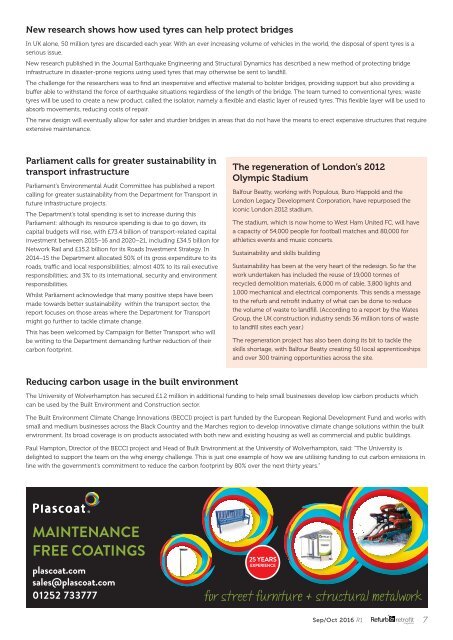R1 R&R Sept '16 52 cc
You also want an ePaper? Increase the reach of your titles
YUMPU automatically turns print PDFs into web optimized ePapers that Google loves.
New research shows how used tyres can help protect bridges<br />
In UK alone, 50 million tyres are discarded each year. With an ever increasing volume of vehicles in the world, the disposal of spent tyres is a<br />
serious issue.<br />
New research published in the Journal Earthquake Engineering and Structural Dynamics has described a new method of protecting bridge<br />
infrastructure in disaster-prone regions using used tyres that may otherwise be sent to landfill.<br />
The challenge for the researchers was to find an inexpensive and effective material to bolster bridges, providing support but also providing a<br />
buffer able to withstand the force of earthquake situations regardless of the length of the bridge. The team turned to conventional tyres; waste<br />
tyres will be used to create a new product, called the isolator, namely a flexible and elastic layer of reused tyres. This flexible layer will be used to<br />
absorb movements, reducing costs of repair.<br />
The new design will eventually allow for safer and sturdier bridges in areas that do not have the means to erect expensive structures that require<br />
extensive maintenance.<br />
Parliament calls for greater sustainability in<br />
transport infrastructure<br />
Parliament’s Environmental Audit Committee has published a report<br />
calling for greater sustainability from the Department for Transport in<br />
future infrastructure projects.<br />
The Department’s total spending is set to increase during this<br />
Parliament: although its resource spending is due to go down, its<br />
capital budgets will rise, with £73.4 billion of transport-related capital<br />
investment between 2015–16 and 2020–21, including £34.5 billion for<br />
Network Rail and £15.2 billion for its Roads Investment Strategy. In<br />
2014–15 the Department allocated 50% of its gross expenditure to its<br />
roads, traffic and local responsibilities; almost 40% to its rail executive<br />
responsibilities; and 3% to its international, security and environment<br />
responsibilities.<br />
Whilst Parliament acknowledge that many positive steps have been<br />
made towards better sustainability within the transport sector, the<br />
report focuses on those areas where the Department for Transport<br />
might go further to tackle climate change.<br />
This has been welcomed by Campaign for Better Transport who will<br />
be writing to the Department demanding further reduction of their<br />
carbon footprint.<br />
The regeneration of London’s 2012<br />
Olympic Stadium<br />
Balfour Beatty, working with Populous, Buro Happold and the<br />
London Legacy Development Corporation, have repurposed the<br />
iconic London 2012 stadium.<br />
The stadium, which is now home to West Ham United FC, will have<br />
a capacity of 54,000 people for football matches and 80,000 for<br />
athletics events and music concerts.<br />
Sustainability and skills building<br />
Sustainability has been at the very heart of the redesign. So far the<br />
work undertaken has included the reuse of 19,000 tonnes of<br />
recycled demolition materials, 6,000 m of cable, 3,800 lights and<br />
1,000 mechanical and electrical components. This sends a message<br />
to the refurb and retrofit industry of what can be done to reduce<br />
the volume of waste to landfill. (A<strong>cc</strong>ording to a report by the Wates<br />
Group, the UK construction industry sends 36 million tons of waste<br />
to landfill sites each year.)<br />
The regeneration project has also been doing its bit to tackle the<br />
skills shortage, with Balfour Beatty creating 50 local apprenticeships<br />
and over 300 training opportunities across the site.<br />
Reducing carbon usage in the built environment<br />
The University of Wolverhampton has secured £1.2 million in additional funding to help small businesses develop low carbon products which<br />
can be used by the Built Environment and Construction sector.<br />
The Built Environment Climate Change Innovations (BECCI) project is part funded by the European Regional Development Fund and works with<br />
small and medium businesses across the Black Country and the Marches region to develop innovative climate change solutions within the built<br />
environment. Its broad coverage is on products associated with both new and existing housing as well as commercial and public buildings.<br />
Paul Hampton, Director of the BECCI project and Head of Built Environment at the University of Wolverhampton, said: “The University is<br />
delighted to support the team on the whg energy challenge. This is just one example of how we are utilising funding to cut carbon emissions in<br />
line with the government’s commitment to reduce the carbon footprint by 80% over the next thirty years.”<br />
®<br />
MAINTENANCE<br />
FREE COATINGS<br />
25 YEARS<br />
EXPERIENCE<br />
plascoat.com<br />
sales@plascoat.com<br />
012<strong>52</strong> 733777<br />
for str<br />
reet furniture & str<br />
ructural meta<br />
alwork<br />
Sep/Oct 2016 <strong>R1</strong> Refurb retrofit<br />
magazine<br />
7

















